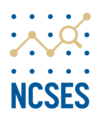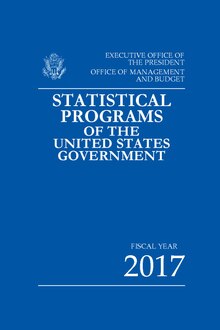Network of 13 statistical bodies of the federal government
The Federal Statistical System of the United States is the decentralized network of federal agencies which produce data and official statistics about the people, economy, natural resources, and infrastructure of the United States. It is led by the Chief Statistician of the United States (CSOTUS) and the Interagency Council on Statistical Policy, and is composed of 13 principal statistical agencies and 3 recognized statistical units, 24 Statistical Officials (across 24 major cabinet agencies), approximately 100 additional Federal statistical programs engaged in statistical activities, and several cross system interagency and advisory bodies.[1]
Background
In contrast to many other countries, the United States does not have a primary statistical agency.[2] Instead, the statistical system is decentralized, with 13 statistical agencies, two of which are independent agencies and the remaining 11 generally located in different government departments. This structure keeps statistical work in close proximity to the various cabinet-level departments that use the information.[2] In addition, three other statistical units of government agencies are recognized by the OMB as having statistical work as part of their mission.
As of fiscal year 2013 (FY13), the 13 principal statistical agencies have statistical activities as their core mission and conduct much of the government’s statistical work.[2] A further 89 federal agencies were appropriated at least $500,000 of statistical work in FY11, FY12, or FY13 in conjunction with their primary missions.[3] All together, the total budget allocated to the Federal Statistical System is estimated to be $6.7 billion for FY13.[3] In FY20, FY21, and FY22, the total budgets allocated to the Federal Statistical System are estimated to be $12.0, $7.0, and $7.1 billion, respectively. The larger budget size of FY20 is attributable to the 2020 census, amounting to 54% of the FY20 budget.[4]
The Federal Statistical System is coordinated through the Office of Management and Budget (OMB). OMB establishes and enforces statistical policies and standards, ensures that resources are proposed for priority statistical programs, and approves statistical surveys conducted by the Federal government under the Paperwork Reduction Act.[5] The Chief Statistician of the United States, also housed within OMB, provides oversight, coordination, and guidance for Federal statistical activities, working in collaboration with leaders of statistical agencies.[5]
Centralization efforts
To streamline operations and reduce costs, several proposals have been made to consolidate the federal statistical system into fewer agencies, or even a single agency.[6] In 2011, President Barack Obama's proposal to reorganize the U.S. Department of Commerce included placing several statistical agencies under one umbrella.[7]
Principal statistical agencies
Total staff levels of principal statistical agencies 2019-2022[4]
| Agency
|
2019
|
2020
|
2021
|
2022
|
| Census Bureau
|
46,117
|
317,661
|
37,573
|
17,403
|
| Bureau of Labor Statistics
|
2,193
|
2,200
|
2,228
|
2,360
|
| National Center for Education Statistics
|
93
|
93
|
96
|
98
|
| National Agricultural Statistics Service
|
894
|
870
|
892
|
911
|
National Center for Health Statistics
(Centers for Disease Control and Prevention)
|
501
|
481
|
486
|
481
|
| Energy Information Administration
|
333
|
359
|
359
|
366
|
| Bureau of Economic Analysis
|
503
|
455
|
495
|
495
|
| Economic Research Service
|
316
|
329
|
275
|
332
|
| Bureau of Justice Statistics
|
56
|
50
|
53
|
53
|
National Center for Science and Engineering Statistics
(National Science Foundation)
|
57
|
57
|
54
|
54
|
Statistics of Income Division
(Internal Revenue Service)
|
139
|
140
|
144
|
138
|
| Bureau of Transportation Statistics
|
60
|
61
|
63
|
80
|
Office of Research, Evaluation, and Statistics
(Social Security Administration)
|
80
|
70
|
69
|
68
|
Note: Statisticians include statisticians and mathematical statisticians, and research scientists include health
scientists, epidemiologists, and educational research scientists. Other statistical personnel may include social science analysts, social insurance administrators, economic assistants, geographers, spatial data analysts, program
supervisors, program managers, program analysts, accountants, general engineers, mechanical engineers, writers and editors, visual designers, geologists, cartographers, librarians, operations research analysts, mathematicians, statistical assistants, transportation specialists, transportation industry analysts, and information technology managers—position.
Statistical units
These are subcomponents of agencies recognized by the OMB as having statistical work as part of their mission:
Cross system bodies
Interagency Council on Statistical Policy
Started in 1989, the Interagency Council on Statistical Policy (ICSP) was originally created to improve communication among the heads of the principal statistical agencies, and later was charged with advising and assisting the CSOTUS. The Evidence Act expanded membership to include the newly established Statistical Officials across major cabinet agencies, 11 of which are also heads of principal statistical agencies. The ICSP, led by the CSOTUS, supports implementation of the statistical system's vision to operate as a seamless system, working together to provide strategic vision and robust implementation in support of the U.S. Federal statistical system's critical longstanding — and expanding — role for supporting evidence-based decision-making. For example, the ICSP sets strategic goals for modernizing the statistical system, as well as enhancing coordination and collaboration across the system, recognizing the efficiencies and advancements possible when taking advantage of the whole system's statistical infrastructure and expertise.[1]
Federal Committee on Statistical Methodology
The mission of the Federal Committee on Statistical Methodology (FCSM) includes advising the CSOTUS and ICSP on methodological and statistical issues that affect the quality of Federal data. The FCSM sponsors regular conferences, hosts seminars and workshops, sponsors interest groups on statistical methodology topics of broad Federal interest, and develops best practices and tools to support the Federal statistical system and the broader Federal data community.[1]
Federal Economic Statistics Advisory Committee
The Federal Economic Statistics Advisory Committee (FESAC) advises the Directors of the Bureau of Economic Analysis and the Bureau of the Census and the Commissioner of the Bureau of Labor Statistics on statistical methodology and other technical matters related to the collection, tabulation, and analysis of federal economic statistics.[1]











